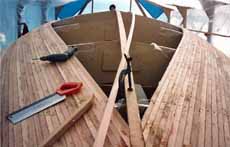sailboat hull material types
Hull material strongly influences the look and feel of the boat. metal boats tend to the industrial strength go-anywhere-any-time look that can be very impressive and pleasing if well executed. wooden boats tend to fall into the fussy, look-but-don’t-touch category or, at the other extreme, the hairy old, gaff and baggy-wrinkled character. Boat hull types. the hull. the ‘hull’ is the portion of your boat that rides both in and on top of the water. the hull does not include any masts, sails, rigging, machinery or equipment. there are three general hull types: planing hull: this hull type is designed to glide on the surface of the water as the boat gains speed (most powerboats. In a multi-hull boat, it needs a large area when either tacking or jibing. main parts of a hull. there’s some terminology i threw around while describing the many types of hulls a sailboat and other types of boats have. as is the case with a lot of activities, learning the terminology is just something you have to do.. 

sailboat hull material types Wood is the traditional boat building material used for hull and spar construction. it is buoyant, widely available and easily worked. it is a popular material for small boats (of e.g. 6-metre (20 ft) length; such as dinghies and sailboats). its abrasion resistance varies according to the hardness and density of the wood and it can deteriorate. Prior to the development of fiberglass construction techniques, boats were built of wood, steel, and other materials, by assembling pieces and parts into a structure which was then sheathed with a hull. with fiberglass boat building, however, the major components of the boat – the hull, deck, liner, and large parts like consoles—are molded.